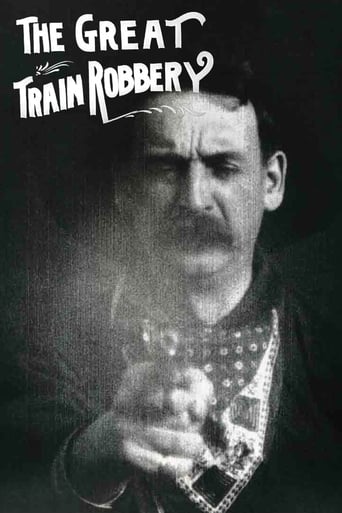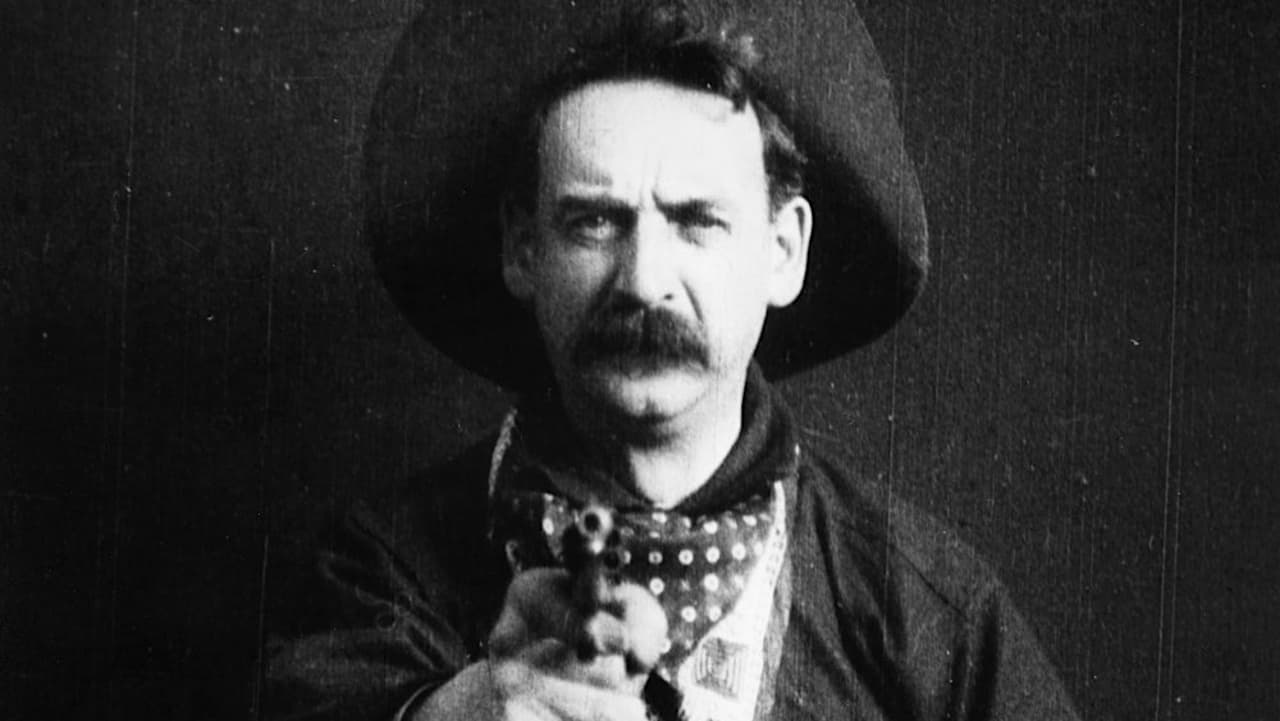He_who_lurks
I remember when I first saw this short American landmark film I was drawn right in. My eyes were glued to the TV. I wasn't even a little bored. I sat and watched for a full 10 minutes and after the watch I had a feeling of sensation. This movie is chock full of action and violence. There isn't hardly a dull moment, because the action begins right within the first few seconds of the film! Edwin S. Porter sure knew how to draw his viewers in. Probably the best part is the chase scene. And the part where the leader of the gang fires his six-shooter at the camera is all too quick.The film begins in a telegraphist's office, where two of the bandits make him send a telegraph to the conductor to stop the train. Then all 4 bandits sneak aboard and make the engineer disconnect the locomotive from the other cars so the thieves can escape. But, in the end the telegraphist's daughter finds him and unties him. An alarm is given, and the bandits are chased and in the end shot down. Then the part comes where the bandit fires away at the camera to finish the film. I wonder if that was frightening for the audience in 1903? Possibly, but I think enough time had gone by for audiences to know that what they were watching really just an image on a screen.The print I've watched includes hand-coloring in some spots, including the famous image at the end. Mostly, the coloring is used to show explosions of gun smoke, but the dancers in the dance hall have their dresses colored too as well as the banners.On a side note, the famous shot was not always shown at the end of the film. According to what I've read, exhibitors could choose whether to put it at either the beginning or end of the short. As far as I know, it is most common for it to be at the end.
alfCycle
This film is very simple and straight forward. By today's standards there is nothing remotely new. However, when looked at in the context of the time it was released, it is easy to see how influential this movie would become. So many future films, particularly westerns, can be traced back to the basic formula of this movie. The final scene of Goodfellas even has an homage to this film. Apparently, audiences at the time jumped out of their seats with fear at the last scene, which I can understand for a person who had never seen a movie in their life. Recommended to anyone interested in the history of film making.7/10...but that's just like, my opinion, man# Of Times Watched: Once
WakenPayne
I would say watch this movie with the intention in mind that film had only really existed for about 15 years maximum considering I've seen footage from the 1880's. I will say that back then there was no story to speak of with any movie at the time and I don't think many people saw the potential for what it could do. So this gave birth to film editing. I will say the plot is really nothing special but being that this is the first go at editing in history I thought I should talk about the technical elements. I was impressed by how much this felt like it was The Wild West and I also liked how many people they took in to get this made when at this point, film was just a cheap amusement to the public eye. But there are some weaknesses with it, To say the number of robbers in the robbery is inconsistent is an understatement. First there's 2, then 4, then 3 it's a mess. That and I don't know what the significance of the last shot is. It's one of a guy in a stationary location that has nothing to do with what has been seen looking directly at you and firing a gun. I guess because back then editing was a new concept that they could get some of the cheap amusement side of it that it was at the time at the ending but I don't think it ages well. All in all, I would say watch it if you're a fan of westerns or want to know about film history.
des-47
Though by no means the first with a Western setting, this film was a breakthrough for the genre and, with a plot involving black-clad trigger happy bandits holding up a train then receiving rough justice at the hands of a posse following a horseback chase, helped established several elements of its iconography. Like so much else that was later to seem newly minted for the cinema, these images had precedents in other media, including popular fiction, graphic art and touring stage spectacles known as Wild West Shows which presented a romanticised, gun-totin' version of the American West in the late Victorian period. But location filming provided the opportunity to present these elements in a new setting of realistic visual grandeur and scale – even if, as here, New Jersey stood in for the West.Like various other longer narrative films in these early days, The Great Train Robbery tells its story largely by stringing together a succession of tableaux, with studio and location scenes staged alike in long shot. At around 12 minutes, with 14 shots, it builds in length, ambition and achievement on Edison director Edwin S Porter's Life of an American Fireman, released a few months earlier, though in some respects is less visually imaginative. A lengthy scene where the villains force passengers off the train and rob them shows the limitations of the technique: the shot is perfectly set up for the dramatic death of a would-be escapee who runs towards the camera before being killed, and later after the bandits depart and the crowd swarms round the corpse, but otherwise it's difficult to see what's going on.Elsewhere Porter makes good use of the opportunities for movement and energy. He shoots from the back of a moving locomotive across the top of the cab to the track ahead as the villains stalk towards the crew. And a contemporary director would likely choose a similar camera position for the shot where the mounted bandits are chased through the woods by the posse, exchanging gunfire as they go. Notably, there are two early examples of camera movement, put to very good use when the villains leave the hijacked loco. The camera pans and tilts with the characters, setting up the expectation that there's something of interest just off frame, which is then revealed as a group of waiting horses on which they make their final escape.But the film is best known for a shot completely tangential to the narrative, in which actor Justus D Barnes, as the leader of the gang, expressionlessly points his revolver at the camera and fires six shots at point blank range. The shot is usually placed at the end of the film, after the character has been killed on screen, but Porter suggested it could also be re-edited as the opening shot if distributors preferred. It's a striking image of violence directed at the audience, but there are now no reports of screaming and ducking as with the Lumières' train.Far from being 'realistic', the shot, and the film as a whole, exemplify the growing tendency of cinema to exploit the vicarious thrill of danger and violence in a contained, safe space. The image is cinema's second enduring icon after Méliès' moon, and has been much parodied and homaged, most notably in Martin Scorsese's Goodfellas, with Joe Pesci's psychotic gangster standing in for Barnes' outlaw. But in the later film it's actually the penultimate shot. It's followed by a view of the narrator, Ray Liotta's police informer, smiling smugly at the camera before retreating into the comfortable suburban home he occupies under his new identity, safe in the knowledge that the bad guys and their guns are now illusions, locked in their cel(l) of film.


 AD
AD




